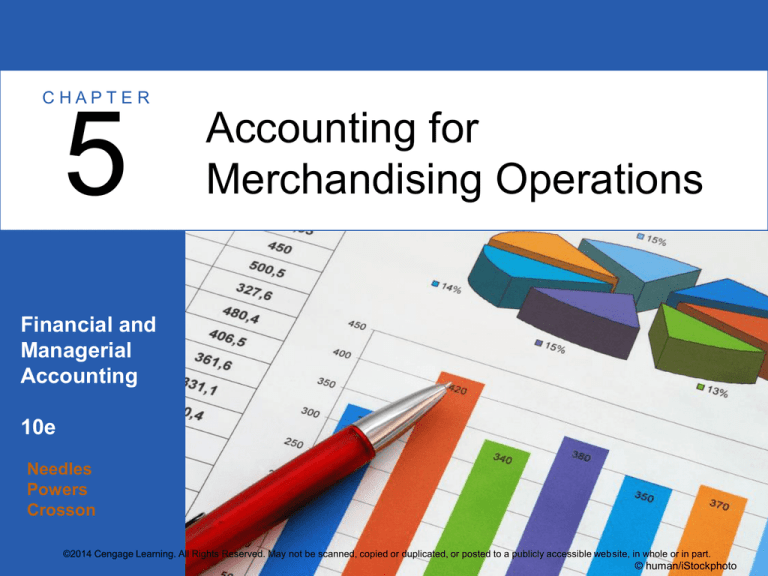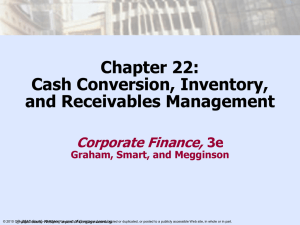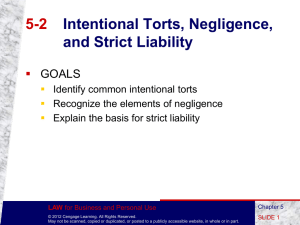
CHAPTER
5
Accounting for
Merchandising Operations
Financial and
Managerial
Accounting
10e
Needles
Powers
Crosson
©2014 Cengage Learning. All Rights Reserved. May not be scanned, copied or duplicated, or posted to a publicly accessible website, in whole or in part.
© human/iStockphoto
Concepts Underlying
Merchandising Accounting (slide 1 of 2)
A merchandising company earns income by
buying and selling goods, which are called
merchandise inventory.
– The buying and selling of goods adds to the complexity
of the accounting process.
– Merchandise inventory is an important component on
the operating cycle, which is the cycle of buying and
holding merchandise until it is sold and then collecting
payment for the sales.
©2014 Cengage Learning. All Rights Reserved. May not be scanned, copied or duplicated, or posted to a publicly accessible website, in whole or in part.
Concepts Underlying
Merchandising Accounting (slide 2 of 2)
Two basic systems of accounting for merchandise
inventory are used:
- Perpetual inventory
- Periodic inventory
system—Under this system,
system—Under this system,
continuous records are kept
the inventory not yet sold is
of the quantity and, usually,
counted periodically.
The physical count is called
the cost of individual items
physical inventory, which is
as they are bought and
usually taken at the end of the
sold.
accounting period.
At all times, the balance of the
Merchandise Inventory account
equals the cost of goods on
hand.
The figure for inventory is
accurate only on the balance
sheet date.
©2014 Cengage Learning. All Rights Reserved. May not be scanned, copied or duplicated, or posted to a publicly accessible website, in whole or in part
Multistep Income Statement
A multistep income statement goes through a
series of steps or subtotals to arrive at net
income.
– In the income statement of a service company (which provides
services as opposed to products), the operating expenses are
deducted from revenues in a single step to arrive at income from
operations.
– The income statements of manufacturing companies (which make
and sell products) and merchandising companies (which buy and
sell products) include an additional step of calculating gross
margin by subtracting the cost of goods from net sales.
©2014 Cengage Learning. All Rights Reserved. May not be scanned, copied or duplicated, or posted to a publicly accessible website, in whole or in part.
Net Sales and Cost of Goods Sold
Net sales (or net revenue) is computed as follows:
Net Sales = Gross Sales − Sales Returns and Allowances
– Gross sales consist of the total revenue from cash and credit sales
during a period.
– Sales returns and allowances include cash refunds and credits on
account. They also include any discounts from selling prices made
to customers who have returned defective or unsatisfactory
products.
Cost of goods sold (or cost of sales or cost of revenue) is
the amount a merchandiser paid for the merchandise it
sold during a period.
©2014 Cengage Learning. All Rights Reserved. May not be scanned, copied or duplicated, or posted to a publicly accessible website, in whole or in part.
Gross Margin and Income from Operations
Gross margin (or gross profit) is computed as follows:
Gross Margin = Net Sales − Cost of Goods Sold
– Managers and owners are also interested in percentage of gross
margin, which is computed as follows:
Percentage of Gross Margin = Gross Margin ÷ Net Sales
Income from operations (or operating income) is the income
from a company’s main business and is computed as follows:
Income from Operations = Gross Margin − Operating Expenses
©2014 Cengage Learning. All Rights Reserved. May not be scanned, copied or duplicated, or posted to a publicly accessible website, in whole or in part.
Operating Expenses
Operating expenses are the expenses, other than cost of
goods sold, that are incurred in running a business. They
are computed as follows:
Operating Expenses = Selling Expenses +
General and Administrative Expenses
– Selling expenses include the costs of storing goods and preparing
them for sale; preparing displays, advertising, and otherwise
promoting sales; and delivering goods to the buyer.
– General and administrative expenses include accounting,
personnel, credit checking, collections, and any other expenses that
apply to overall operations.
©2014 Cengage Learning. All Rights Reserved. May not be scanned, copied or duplicated, or posted to a publicly accessible website, in whole or in part.
Other Revenues and Expenses
Other revenues and expenses (or nonoperating revenues
and expenses) are not related to a company’s operating
activities. These include:
– revenues from investments (such as dividends on stock)
– interest expenses and other expenses that result from
borrowing money
©2014 Cengage Learning. All Rights Reserved. May not be scanned, copied or duplicated, or posted to a publicly accessible website, in whole or in part.
Income before Income Taxes and Net Income
Income before income taxes is the amount on which
income taxes will be determined and is computed as
follows:
Income before Income Taxes = Income from Operations +/ − Other
Revenues and Expenses
Net income (or net earnings) is the final figure, or “bottom
line,” of an income statement and is computed as follows:
Net Income = Income before Income Taxes − Income Tax Expense
©2014 Cengage Learning. All Rights Reserved. May not be scanned, copied or duplicated, or posted to a publicly accessible website, in whole or in part.
Single-Step Income Statement
In a single-step income statement, net income is derived
in a single step by putting the major categories of
revenues in the first part of the statement and the major
categories of costs and expenses in the second part.
Both the multistep form and the single-step form have
advantages.
– The multistep form shows the components used in deriving net
income.
– The single-step form has the advantage of simplicity.
©2014 Cengage Learning. All Rights Reserved. May not be scanned, copied or duplicated, or posted to a publicly accessible website, in whole or in part.
Terms of Sale
Manufacturers and wholesalers often quote prices as a
percentage off their list or catalogue prices. Such a
reduction is called a trade discount.
– If an article is listed at $1,000 with a trade discount of
40 percent, or $400, the seller records the sale at $600,
and the buyer records the purchase at $600.
If an invoice is marked “n/30” (“net 30”), the invoice is
due 30 days after the invoice date. If the invoice is
marked “n/10 eom,” it is due 10 days after the end of
the month (“eom”).
©2014 Cengage Learning. All Rights Reserved. May not be scanned, copied or duplicated, or posted to a publicly accessible website, in whole or in part.
Sales and Purchases Discounts
In some industries, it is customary to give a sales discount
for early payment.
– An invoice that offers a sales discount of “2/10, n/30” means that
the buyer either can pay within 10 days of the invoice date and
receive a 2 percent discount or wait 30 days and pay the full
amount.
Purchase discounts are discounts that the buyer takes for
the early payment of merchandise.
– Both the seller and the buyer record the purchase at the full
amount. If the buyer pays in time to get the discount, it is recorded
as “Sales Discount” for the seller and “Purchases Discount” for the
buyer.
©2014 Cengage Learning. All Rights Reserved. May not be scanned, copied or duplicated, or posted to a publicly accessible website, in whole or in part.
Transportation Costs
(slide 1 of 2)
Special terms designate whether the seller or purchaser
pays the freight charges:
– FOB shipping point means that the seller places the
merchandise “free on board” at the point of origin and
the buyer bears the shipping costs. The title to the
merchandise passes to the buyer at that point.
– FOB destination means that the seller bears the
transportation costs to the delivery point. The seller
retains title until the merchandise reaches its destination
and usually prepays the shipping costs, in which case
the buyer makes no accounting entry for freight.
©2014 Cengage Learning. All Rights Reserved. May not be scanned, copied or duplicated, or posted to a publicly accessible website, in whole or in part.
Transportation Costs
(slide 2 of 2)
When the buyer pays the transportation charge, it
is called freight-in, and it is added to the cost of
merchandise purchased.
When the seller pays the transportation charge, it
is called delivery expense (or freight-out), and it
is included in selling expenses on the income
statement.
©2014 Cengage Learning. All Rights Reserved. May not be scanned, copied or duplicated, or posted to a publicly accessible website, in whole or in part.
Perpetual Inventory System
Under the perpetual inventory system, Merchandise
Inventory and Cost of Goods Sold are continually
updated during the accounting period as purchases,
sales, and other inventory transactions occur.
©2014 Cengage Learning. All Rights Reserved. May not be scanned, copied or duplicated, or posted to a publicly accessible website, in whole or in part.
Periodic Inventory System
(slide 1 of 2)
Under the periodic inventory system, cost of goods
sold must be computed on the income statement
because it is not updated for purchases, sales, and
other transactions during the accounting period.
It is important to distinguish between the cost of
goods sold and the cost of goods available for
sale.
– The cost of goods sold is the cost of merchandise
actually sold in the accounting period.
©2014 Cengage Learning. All Rights Reserved. May not be scanned, copied or duplicated, or posted to a publicly accessible website, in whole or in part.
Periodic Inventory System
(slide 2 of 2)
– The cost of goods available for sale is the total cost of
merchandise that could be sold in the accounting
period. It is the sum of the following two factors:
The amount of merchandise on hand at the beginning of the
period.
The net cost of purchases during the period. (Net cost of
purchases consists of total purchases plus freight-in less any
deductions, such as purchases returns and allowances and
discounts from suppliers for early payment.)
– The difference between cost of goods available for
sale and cost of goods sold is the amount not sold, or
the ending merchandise inventory.
©2014 Cengage Learning. All Rights Reserved. May not be scanned, copied or duplicated, or posted to a publicly accessible website, in whole or in part.
Cash Flows in the Operating Cycle
©2014 Cengage Learning. All Rights Reserved. May not be scanned, copied or duplicated, or posted to a publicly accessible website, in whole or in part.
The Financing Period
The financing period (or cash gap) is the amount
of time from the purchase of inventory until it is
sold and payment is collected, less the amount of
time creditors give the company to pay for the
inventory.
©2014 Cengage Learning. All Rights Reserved. May not be scanned, copied or duplicated, or posted to a publicly accessible website, in whole or in part.
Foreign Business Transactions
An international business transaction is measured
in two different currencies, and one currency has
to be translated into another by using an
exchange rate.
If a U.S. company bills a foreign company in the
foreign company’s currency and accepts payment
in the foreign currency, it will incur an exchange
gain or loss if the exchange rate changes
between the date of the sale and the date of
payment.
©2014 Cengage Learning. All Rights Reserved. May not be scanned, copied or duplicated, or posted to a publicly accessible website, in whole or in part.









